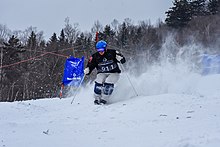Loading AI tools
Discipline of freestyle skiing From Wikipedia, the free encyclopedia
Mogul skiing is a freestyle skiing competition consisting of one timed run of free skiing on a steep, heavily moguled course, stressing technical turns, aerial maneuvers and speed.[1] Internationally, the sport is contested at the FIS Freestyle World Ski Championships, and at the Winter Olympic Games.
 An athlete mogul skiing at Waterville Valley Resort | |
| Highest governing body | International Ski and Snowboard Federation |
|---|---|
| Characteristics | |
| Type | Freestyle skiing |
| Presence | |
| Country or region | Worldwide |
| Olympic |
|

Moguls are a series of bumps on a piste formed when skiers push snow into mounds as they do sharp turns. This tends to happen naturally as skiers use the slope but they can also be constructed artificially. Once formed, a naturally occurring mogul tends to grow as skiers follow similar paths around it, further deepening the surrounding grooves known as troughs. Since skiing tends to be a series of linked turns, moguls form together to create a bump field.
The term "mogul" is from the Bavarian/Austrian German word Mugel, meaning "mound, hillock".[2]

The first competition involving mogul skiing occurred in 1971. The FIS created the Freestyle World Cup Circuit in 1980. The first World Championships were held in 1986, and are currently held in odd-numbered years. It was a demonstration sport in freestyle skiing at the 1988 Winter Olympics in Calgary. It has been a medal event in the Winter Olympics since 1992.
Mogul courses are between 200 and 270 metres with an average slope grade of 26 degrees. The moguls themselves are set approximately 3.5 metres apart. The course includes two small jumps which are used as a take-off for aerial maneuvers. Athletes can perform upright or inverted tricks off these jumps in the course of a competition run.[3] Dual Mogul competition consists of elimination rounds where pairs of competitors compete against each other. Each loser is eliminated and each winner advances to the next round until a final result is achieved.
Seamless Wikipedia browsing. On steroids.
Every time you click a link to Wikipedia, Wiktionary or Wikiquote in your browser's search results, it will show the modern Wikiwand interface.
Wikiwand extension is a five stars, simple, with minimum permission required to keep your browsing private, safe and transparent.